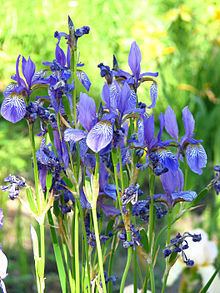Subgenus I. subg. Limniris | Scientific name Sibiricae Rank Series | |
 | ||
Similar Irises, Iris sibirica, Iris pumila, Gillenia, Iris japonica | ||
Iris ser. Sibiricae are a series of the genus Iris, in Iris subg. Limniris.
The series was first classified by Diels in 'Die Natürlichen Pflanzenfamilien' (Edited by H. G. A. Engler and K. Prantl) in 1930. It was further expanded by Lawrence in Gentes Herb (written in Dutch) in 1953.
Iris sibirica and Iris sanguinea were first recorded and described in the 18th century, but date back in Europe before that. They were used in herbal remedies, to cure ulcers, remove freckles and cure other ladies problems. In the 19th century, they were more used as garden plants and hybrids were started being developed. In the 1920s and 1930s, American breeders also started creating new hybrids.
Most species are easy to grow in temperate zones (including the UK). They prefer semi-shaded positions, that contain moisture during the summer. They also need soils with a pH level of more than 7.
In the 1970s, the 'Society for Siberian Irises in North America' did some chromosomal research into the series and found that the series was divided into two groups. One with 40 chromosomes (such as Iris chysographes) and the other only have 28 chromosomes (such as Iris siberica). It was published by L.W.Lenz in 'Aliso' in 1976.
The society then decided to divide the group by this division. The 28 chromosomal group is sometimes known as the 'Sino-Siberians' (based on the native origin of most of the group).
The Sino-siberians include; Iris bulleyana, Iris chrysographes, Iris clarkei, Iris delavayi, Iris forrestii and Iris wilsonii. The 40 chromosomal group contains Iris sanguinea, Iris siberica and Iris typhifolia.
The Morgan-Wood Medal is given out by the American Iris Society, since 1951. It honours the work of F. Cleveland Morgan (1882-1962) and Ira E. Wood (1903-1977). It is given to siberian irises judged to be the best of the best, that year.
Includes;
